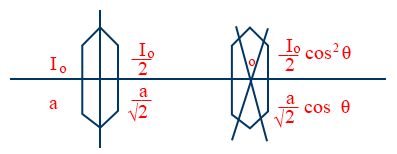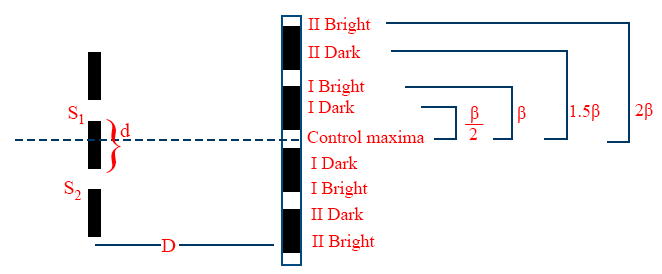Wave Optics
Polarisation
- Polarisation is the property of obstructing the vibration of particle.
- Polarisation Establishes the transverse nature of Light waves
- If the Electric vector vibrates in all directions in a plane perpendicular to the direction of propagation is called unpolarised light.
- If the Electric field vector is contained to a plane passing through the direction of propagation it is called plane polarised light.
- Polariser is the crystal used to polarise the unpolarised light.
- Analyser is the crystal used to analyse the polarised light.
- Malus law is given by I = I0 cos2 θ
- Amplitude from malus law a = a0 cos θ
-

- When three polaroids are present with consecutive angles θ1 and θ2 Then \tt I^{1}=\frac{I}{2}\cos^{2}\theta_{1}\cos^{2}\theta_{2}
- polarising angle or Brewster's angle is the angle of incidence at which reflected light is polarised.
- Brewster law States that tangent of polarising angle is equal to refractive index μ = Tan θp
- \tt \tan\ \theta_{p} =\frac{\mu}{1};\sin\ \theta_{p} =\frac{\mu}{\sqrt{\mu^{2}+1}};\cos\ \theta_{p} =\frac{1}{\sqrt{\mu^{2}+1}}
- Ordinary ray in double refraction is that ray which obeys laws of refraction.
- Extraordinary ray in double refraction is that ray which does not obeys law of refraction.
- For ordinary ray \tt \mu_{0}=\frac{\sin i}{\sin r}
- Optic axis the axis along which ordinary and Extraordinary rays have same speed.
- Dichroism is the property of unequal absorption of ordinary and Extraordinary rays by some crystals.
- man made polarising materials are called polaroids
- Polarisation is used to study the helical structure of nucleic acids
- Polarisation is used in polaroid sun goggles.
- Optical activity of a substance is measured with the help of polarimeter
- Speed of light wave is same it is called isotropic media
- Speed of light wave is not same it is called anisotropic media
- Diffraction pattern is due to interference of light from secondary waves of the same wave front
- Sound waves cannot be polarised
- Intensity of fraunhoffer diffraction at single slit \tt I_{0}=I_{0}\left(\frac{\sin\alpha}{\alpha}\right)^{2}\ where\ \alpha=\frac{\pi a}{\lambda}\ \sin\theta
- Youngs double slit Experiment

View the Topic in this video From 00:14 To 3:54
Disclaimer: Compete.etutor.co may from time to time provide links to third party Internet sites under their respective fair use policy and it may from time to time provide materials from such third parties on this website. These third party sites and any third party materials are provided for viewers convenience and for non-commercial educational purpose only. Compete does not operate or control in any respect any information, products or services available on these third party sites. Compete.etutor.co makes no representations whatsoever concerning the content of these sites and the fact that compete.etutor.co has provided a link to such sites is NOT an endorsement, authorization, sponsorship, or affiliation by compete.etutor.co with respect to such sites, its services, the products displayed, its owners, or its providers.

